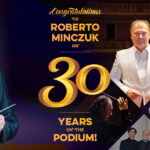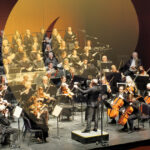Concert Review: Rachmaninoff and Ravel
This review appeared in the March 2012 Albuquerque Journal. Reprinted with kind permission.
Review of NMPhil March 9, 2013 Concert
by D.S. Crafts
The Russians seem to have the last word in big, bold piano concertos. New works come and go but fail to remain in the repertoire. The concertos of Rachmaninoff and Prokofiev are the last significant entries to have survived (Ravel and Bartok notwithstanding). Not surprisingly so, as only works with strong, characteristic melody become favorites, and only those sufficiently impressive as virtuoso showpieces.
For many years the Rachmaninoff Piano Concerto No. 3 was the sole province of the composer and Vladimir Horowitz. Only a soloist of the highest caliber should even attempt it in concert. Step forward Alexander Gavrylyuk.
Saturday night the New Mexico Philharmonic conducted by Hélène Bouchez took on this great work with guest pianist Gavrylyuk, producing a phenomenal display of music-making at its extreme. The Third represents not only a supreme challenge for even the most talented performers, but its unusual length spans nearly 45 minutes even when taken in brisk tempi. The soloist is given barely a moment’s rest.
The initial approach to the Allegro was light and lyrical, even Impressionistic, making the eruption in the middle, as explode it did, all the more dramatically arresting. The Ukranian pianist chose the original massive-chordal cadenza, rather than the more scherzo-like revision which Rachmaninoff himself recorded. Gavrylyuk has technique to spare producing voluminous cascades of sound too fast to be heard as individual notes but felt only as gossamer swirls of aural color, growing light and dark with harmonic and dynamic shifts.
The partnership of soloist and conductor kept an admirable balance throughout, even in the resonant Popejoy Auditorium. Nothing was obscured and everything that needed to be prominent came forth clearly within the richly complex orchestral palate.
The Finale: Alla breve sparkled in its Mendelssohn-like fairy figurations in the highest piano register, then soared with striking and distinctive melody which is uniquely Rachmaninoff. Not just a show of phenomenal virtuosity and confidence, Gavrylyuk’s playing clearly delineated the spacious and richly-varied design throughout.
An immediate and shouting standing ovation was the only possible response. As if that were not enough, Gavrylyuk returned for an encore, the Liszt/Horowitz adaptation of Mendelssohn’s Wedding March, a bravura bon bon of the first order. In lieu of a review, one is tempted to submit simply a huge, bold exclamation mark.
The first and second suites from Ravel’s ballet Daphnis et Chloé comprised the second half. Eroticism in music? Look no further. Bouchez elicited some luscious textures from the Philharmonic evoking the transcendent quality of myth in this story of love and passion.
The ending of the first Suite stopped on a white hot dime, leading into the sweeping orchestral contours of the “Lever du jour” (Daybreak). Valerie Potter’s outstanding flute solo highlighted the “Pantomime” section, the play within the play. The final bacchanalian scene, “Danse général,” following the wedding of the shepherd and shepherdess, culminated in waves of pounding sonority, Bouchez all but dancing on the podium.




